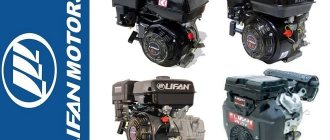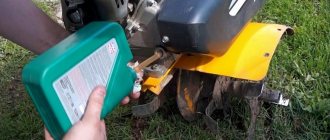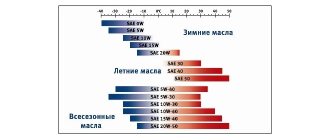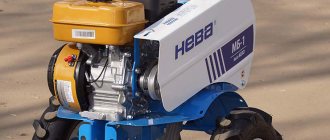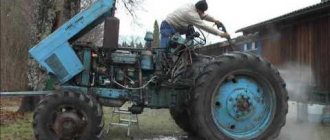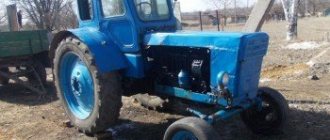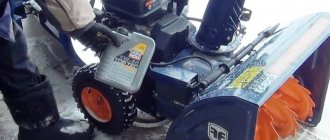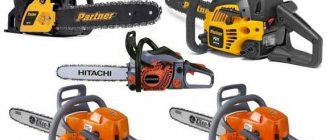Light agricultural machinery also requires attentive maintenance and care, just like complex, powerful units. What kind of oil to pour into the engine of a Lifan walk-behind tractor is a dilemma that worries many users. The brand is quite popular and is in good demand among consumers.
Maintenance
The technical service of the Lifan walk-behind tractor includes a number of measures aimed at preserving internal parts and preventing breakdowns, and specifically:
- Checking the level and changing the oil in the walk-behind tractor engine.
- Checking the level and changing the oil in the walk-behind tractor gearbox.
- Checking, cleaning, replacing the air filter.
- Cleaning the sump.
- Cleaning, adjusting, replacing spark plugs.
- Adjusting valves on a Lifan walk-behind tractor.
- Cleaning the fuel tank.
When performing maintenance, it is important to comply with the manufacturer’s requirements for the use of fuel and oil. What kind of oil to pour
into the walk-behind tractor engine, carefully written in the user's notes. If you use unsuitable oil or fuel,
walk-behind tractor will malfunction. Technical service must be carried out in accordance with the schedule in the annotation.
Tarpan cultivator - attachments
Designed for cutting grass on lawns and lawns to a specified height. It is installed instead of the executive unit and connected to the power unit.
The “Struna” mower with a working width of 0.6 m is designed for mowing grass and weeds both in open areas and in hard-to-reach places near trees, borders, and fences. At cutting head rotation speeds from 3800 to 4600 rpm. The grass is easily cut and thrown aside. Instead of blades, the mower uses a polypropylene pile string. Easily disassembled into a power unit and a working element, the mower can be easily transported in the trunk of a car.
The hiller is used with MK "Tarpan-03, 04" and with MB "Tarpan-07" and consists of a frame and blades adjustable by means of a bar with holes. It is used for hilling vegetable crops, cutting ridges and furrows, sealing furrows. The hiller should be used in conjunction with weeders that create the necessary traction force.
Weeders are used with MK “Tarpan-03, 04” and with MB “Tarpan-07”; they consist of lugs and knives attached to the hub, and are intended for weeding between rows and loosening the soil. The minimum width of the weeded strip is 350 mm. Weeders are installed on the output shaft of the MK gearbox instead of rotary cultivators.
When rotating, the cultivator cutters cut off layers of soil, crumble and mix them, while simultaneously causing the forward movement of the machine.
Grousers 260x80 are used with MK "Tarpan-03, 04"
The transport frame with wheels is used with the Tarpan-03, 04 MK
The protective disk is used with MK "Tarpan-03, 04" and with MB "Tarpan-07"
The “Crow’s Feet” cutter is used with the “Tarpan-03, 04” MK
Design and operation
The principle of operation of the MK: from the engine through the gearbox, the MK shaft is driven into rotation, on which the tillage cutters of the rotary cultivator are installed. The cutters, rotating, loosen the top layer of soil and at the same time move the machine forward. The design of the MK makes it possible to quickly separate power unit 1 from the executive unit 2. To do this, it is necessary to release the hinged bolts 3.
The power unit (Fig. 2) includes a block with a 4-stroke engine 1, a docking device 2, a clutch 3 and a steering control 4
ENGINE. Engine design - see “Engine Operation Manual”.
STEERING allows you to adjust the position of the handles in the vertical and horizontal planes, which makes it possible, with the steering wheel turned horizontally, to cultivate the beds without trampling the soil. For ease of transportation (reducing dimensions), the steering wheel must be turned towards the engine.
The engine remote control unit (Fig. 7) allows you to change engine speed using control lever 2 and stop the engine by pressing the lever down all the way.
The centrifugal clutch (Fig. 4) transmits engine torque to the gearbox when the engine reaches the required number of revolutions. The clutch provides the MK with push-free starting.
ATTENTION! To avoid damage to clutch parts, do not allow the engine to start until the power unit is connected to the gearbox or other operating unit.
It is RECOMMENDED to drop 1-2 drops of motor oil once a season between the pad axle and bushing 4 (two places), used in the engine to improve clutch performance.
The gearbox (Fig. 5) is single-stage, worm, with an oil bath. On the gearbox housing there are bosses with holes that serve for installing a transport device and other attachments.
Rotary cultivator (Fig. 6)
Cultivators 1, 2 - left and right - are installed on the gearbox shaft and secured with axles with clamps.
— stand behind the wheel and firmly grasp the handles;
— slowly press the engine speed control lever, gradually increase the engine speed;
— after the engine has reached the required number of revolutions, the centrifugal clutch is automatically activated, the gearbox shaft begins to rotate, and the MK begins to move. The depth of tillage with rotary cultivator cutters is determined by the position of the depth regulator, which can be changed by rearranging it in the bracket according to the holes available in the regulator.
The milling cutters are driven into the ground by pressing the steering wheel. In this case, the depth regulator is buried in the ground, and the forward movement speed is reduced. The deeper the regulator goes into the ground, the lower the speed of movement of the machine and the greater the depth of processing. If the MK does not move forward, and the cutters are buried in the ground, lift it by the steering wheel.
If the MK moves towards the treated area, the working MK should be shifted in the opposite direction. Turns of the MK must be done by tilting it to the right or left. ATTENTION! Maintain the distance between the unit provided by the length of the steering wheel.
When turning, do not pull the MK towards you, but rather push it away. When processing loose (loose) soil, make sure that the cutters do not go completely deep into the soil, causing overload of the engine. In difficult areas, treat in several stages, in layers, each time increasing the depth of treatment, thereby ensuring good crushing of soil lumps and its uniform structure.
Clean cutters periodically. To reduce the winding of plant residues on the cutters, you can use saber-shaped knives used on the Krot and Salyut machines. During the operation of the machine, the knives of rotary cultivators become dull, which impairs their penetration into the soil, reduces the depth of cultivation per pass, and reduces productivity. Sharpen knives as needed.
Maintenance of the Tarpan cultivator
Hourly and calendar maintenance types must be followed, whichever occurs first. In case of severe operating conditions of the MK, it is necessary to carry out maintenance more often.
Engine maintenance should be carried out in accordance with the Engine Operation Manual.
Types and frequency of maintenance
After the first 5 hours of operation, change the oil in the gearbox.
Every 5 hours or daily - cleaning and wiping the MK.
Checking the tightness of connections of engine parts for oil and fuel leaks. Control of fastening connections. Checking the oil level in the gearbox.
Every 25 hours. or every season - control and cleaning of the clutch.
Every 100 hours or every year - change the oil in the gearbox, lubricate the control rod and control unit.
Source
User manual
Before implementing the MB, it must be assembled and prepared for use. When receiving a cultivator, pay attention to its unit. It should have a sticker with a safety symbol on it. Latest modifications of the Lifan 8 liter engine. With. Lifan have distinctive features that must be taken into account when assembling MB. Modification of the Lifan 900 mm – 1100 mm walk-behind tractor involves the installation of additional equipment to expand the plowed harrow.
When working with a motor cultivator, it is important to observe the following safety precautions:
- Before each start, you should inspect the engine.
- Beware of flammable objects when operating the Lifan .
- Keep children and animals away from the operating MB.
- The tank can only be refilled when the MB is turned off.
- Do not start the engine indoors.
Starting work without running in the Lifan engine leads to premature breakdowns and failure of the equipment.
API Operational Classification
No less popular is the API classification (American Petroleum Institute). It was based on the characteristics of the engine, as well as the type of energy source (gasoline or diesel fuel). According to it, there are 3 main operational categories:
- S – group for gasoline engines. There are the following brands that belong to this group: SA, SB, SC, SD, SE, SF, SG, SH, SJ, SL, SM.
- C – this class is used when operating a diesel engine. In the modern world, there are the following brands for diesel engines: CA, CB, CC, CD, CD-II, CE, CF, CF-2, CF-4, CF-II, CG-4, CH-4, CI-4, CI-4 PLUS, CJ-4
- EU – energy saving brands. They contain mixtures of easily flowing and low-viscosity oil fractions. As a result of research, scientists came to the conclusion that this group reduces fuel consumption during operation of a gasoline engine.
- The fourth group includes universal oils. They can be poured into a walk-behind tractor with a gasoline or diesel engine. They are marked with double markings: SA/CE, SD/CF, SF/CB, etc.
Which brand is better according to this classification? This is quite simple to determine: the closer the second character is to the beginning of the Latin alphabet, the lower the quality. For example, SL is much better than SD oil, and CI-4 is better than CD-II.
What kind of oil to pour into the Lifan walk-behind tractor engine
The Chinese company Lifan is a large corporation that unites many productions: from small-capacity motorcycles to buses.
At the same time, it is also a supplier of engines to a large number of small companies producing agricultural machinery and small vehicles. In accordance with the generally accepted tradition of Chinese industry, instead of developing its own, a successful model, usually Japanese, is copied.
An exception is the widespread 168F family , mounted on a wide range of engine blocks, cultivators, portable generators and motor pumps: the model when it was created was the Honda GX200.
general description
Motor for walk-behind tractor Lifan power 6.5 hp , the price of which ranges from 9 to 21 thousand rubles, depending on the modification, in different stores, has a classic layout: it is a single-cylinder carburetor engine with a lower camshaft and a rod drive (OHV).
Its cylinder is made with an engine housing, which, despite the theoretical possibility of replacing the cast iron liner, significantly reduces its maintainability when the GPG wears out.
The engine has forced air cooling , the performance of which is sufficient when operating in hot climates even under heavy loads.
Ignition system. semiconductor , it does not require any adjustments during operation. The low compression ratio (8.5) of this engine allows it to run on AI-92 of any quality.
At the same time, the specific engine density is 395 g/kWh, i.e. over an hour of operation at a rated power of 4 kW (5.4 hp) at 2500 rpm, with the correct carburetor settings, it will consume 1.1 liters of fuel per hour of operation.
Currently, the 168F engine family includes 7 models with different configuration options and connection sizes, which include the following characteristics:
- Cylinder size (bore/stroke): 68 × 54 mm;
- Working volume: 196 cm³;
- Maximum power output: 4.8 kW at 3600 rpm;
- Rated power: 4 kW at 2500 rpm;
- Maximum torque: 1.1 Nm at 2500 rpm;
- Fuel tank capacity: 3.6 l;
- Engine oil in the crankcase: 0.6 liters.
changes
Lifan 168F-2
The cheapest equipment with a connecting shaft size of 19 or 20 mm. Price from the manufacturer. 9100 rubles.
For more information about the operation of the Lifan 168F-2 engine, see Video:
Lifan 168F-2 7A
The engine variant is equipped with lighting coils , capable of delivering up to 90 W of power to consumers. This allows it to be used on various technologies that require lighting devices: motor tractors, light swamps, etc. Price. 11,600 rubles. Shaft diameter 20 mm.
Lifan 168F-2
The power unit has a tapered shaft output , differs from the base model only in the conical groove of the crankshaft toe, which ensures a more precise and tight fit of the pulleys. Price. 9500 rubles.
Lifan 168F-2L
This engine has a built-in gearbox with a landing diameter of the output shaft of 22 mm and 12,100 rubles.
Lifan168F-2R
The engine is also equipped with a gearbox , but with an automatic centrifugal clutch, and the secondary gear shaft size is 20 mm. Engine cost: 14,900 rubles.
Lifan 168F-2R 7A
As can be seen from the markings, this version of the engine, in addition to a gearbox with an automatic clutch mechanism, has a half-ampere light coil , which increases its price to 16,500 rubles.
Lifan 168FD-2R 7A
The most expensive option, the engine price of 21,500 rubles, differs not only in the diameter of the gearbox output shaft by 22 mm, but also in the presence of an electric starter . However, the rectifier required to charge the battery is not included in the scope of delivery.
Repair and adjustment
Motocross is sooner or later expected on any motorcycle, let it be Cayman, Patriot, Texas, Foreman, Viking, Forza or some others. Its disassembly procedure and defects are simple and do not require any special tools.
It should be noted that the manufacturer does not provide specific wear limits for defects in any engine components, so the data below is provided by analogy with other four-stroke air-cooled engines:
- Drain the oil from the crankcase and gearbox (if installed) by unscrewing the drain plugs and any remaining fuel from the gas cylinder.
- Remove the fuel tank , muffler and air filter.
- Disconnect the carburetor , which is attached to the cylinder head with two pins.
- Remove the manual trigger and fan shroud.
- Fixing the flywheel with an improvised tool, so as not to damage the fan blades, unscrew and secure its nut.
- After this, the three-way universal puller press the flywheel away from the seat cone.
- If the engine starts poorly and the engine power decreases, check whether the keyway is damaged, as this will cause the flywheel to move and the ignition slip angle, determined by the magnetic mark on it, will change.
- Remove the ignition coil and lighting coil, if accessible on the engine.
- After unscrewing the valve cover bolts, unscrew the four cylinder head bolts located under this cover and remove the head. To check the tightness of the valves, turn the combustion chamber head up and fill it with kerosene.
- If kerosene does not appear for a minute on the inlet or outlet channel of the head, the tightness of the valves can be considered satisfactory, otherwise they should be rubbed with an abrasive paste on the seats or (if burnout is detected) replaced.
- On models equipped with a gearbox, remove the cover and output shaft, then push the drive gear or sprocket away from the crankshaft (depending on gearbox type). Mechanisms that have noticeable development on the tooth are replaced.
- Unscrew the bolts holding the rear cover in place and remove it, after which you can remove the camshaft from the crankcase.
- Having thus freed up space in the crankcase, unscrew the bolts connecting the lower connecting rod cover to the body, remove the cover and the crankshaft.
- Press the plunger together with the connecting rod into the crankcase
Reviews
Ruslan, Moscow. I own a 2016 Lifan X60. I remember this crossover was the best-selling among other Chinese SUVs on the Russian market. This is not surprising, given the successful design and pleasant-looking interior with decent equipment. In terms of safety, the car more than corresponds to its class. In the city with a 1.8 engine and an automatic transmission I get 12 liters.
Karina, Ekaterinoslavl. The crossover was purchased last year from the first owner. The car is relatively new, with a 1.8 engine and manual transmission. Basic equipment with air conditioning, electric windows and heated seats. There is also a factory CD radio, but I replaced it with a touch radio so that I could mirror my smartphone onto it. In city driving mode, the crossover consumes 10-11 liters.
Advantages and disadvantages of Lifan walk-behind tractors
Among the shortcomings, users highlight the need to quickly replace the original spark plug, and the strict adherence to the rules of use and technical control. The rest of tractor
Lifan fully corresponds to the stated features and, with proper maintenance, works properly for a long time.
Sources:
https://tachka-moya.ru/raznoe/kakoe-maslo-lit-v-motoblok-lifan.html https://specmahina.ru/motoblok/lifan.html
Briggs&Stratton walk-behind tractor
The unit of the same name is equipped with a gasoline engine, which is cooled by air (so-called convection cooling). Due to this feature, engineers recommend:
- Use synthetic oil ILSAC GF-2 “SJ/CF ENERGY CONVERSING”. It is suitable in any temperature range.
- If the above brand is not available, and the device is forced to operate in subzero temperatures, you need to use Briggs&Stratton 10W-30 branded oil.
- Operating class according to API: SF, SG, SH and higher.
Note: when using grade 5W-30 or higher in warm climates, oil consumption will increase several times. That is why manufacturers need to check its level much more often to avoid unwanted problems.

